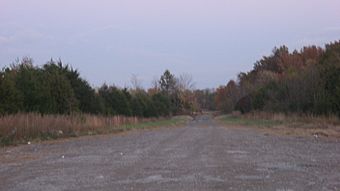Carrier Mills Archaeological District facts for kids
Quick facts for kids |
|
|
Carrier Mills Archeological District
|
|
 |
|
| Location | Along the Saline River south of Carrier Mills, Illinois |
|---|---|
| Area | 143 acres (58 ha) |
| NRHP reference No. | 78001184 |
| Added to NRHP | August 25, 1978 |
The Carrier Mills Archaeological District is a special area in Illinois where archaeologists have found many ancient sites. These sites are located along the Saline River, south of a town called Carrier Mills. It's like a huge outdoor history book that tells us about people who lived here thousands of years ago!
Scientists believe people lived in this area for a very long time. They found evidence of human life from about 2500 B.C. all the way to 700 A.D. That's over 3,000 years of history!
Contents
Discovering Ancient Life
The Carrier Mills Archaeological District is a collection of many different sites. Each site gives us clues about how ancient people lived. By studying these clues, archaeologists can piece together the story of these early communities.
The Oldest Camps: Late Archaic Period
The very first people to live in this area arrived around 2500 B.C. This time is known as the Late Archaic period.
- These early groups were likely hunter-gatherers.
- They moved around to find food and resources.
- Archaeologists found two small campsites and one larger main camp from this time.
- These sites show us where they might have slept, cooked, and made tools.
Early Farmers and Potters: Early Woodland Period
After the Archaic period came the Early Woodland period, which lasted until about 500 B.C. This was a time of big changes for the people living here.
- A major invention during this period was pottery.
- Archaeologists found pieces of pottery at these sites.
- Pottery allowed people to store food and cook more easily.
- Many of these Early Woodland sites are linked to the Crab Orchard culture.
- The Crab Orchard culture was a local group that was part of the larger Hopewell tradition.
The Crab Orchard Culture
The Crab Orchard culture was a unique group of people. They lived in the southern Illinois area.
- They were known for their special pottery styles.
- Their pottery often had designs pressed into the clay.
- They also started to live in more settled villages.
- This shows a shift from constantly moving to staying in one place longer.
Growing Communities: Middle Woodland Period
The Middle Woodland Period followed, from about 300 B.C. to 500 A.D. During this time, the communities at Carrier Mills continued to grow.
- People in this period adopted new technologies.
- They learned from the wider Hopewell culture.
- However, they kept their own local traditions.
- This suggests they were open to new ideas but also proud of their heritage.
Later Discoveries: Late Woodland Period
The latest period found at the district is the Late Woodland period. This period lasted until about 700 A.D.
- Only one artifact from this time has been found so far.
- It is a projectile point, like an arrowhead or spear tip.
- This single find still helps us understand the long history of the area.
A Protected Historic Place
The Carrier Mills Archaeological District is very important for understanding ancient history. Because of its value, it was added to the National Register of Historic Places on August 25, 1978. This means it is a protected site. It helps make sure these ancient stories can be studied and preserved for future generations.



